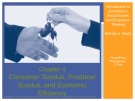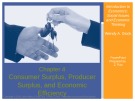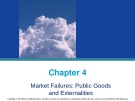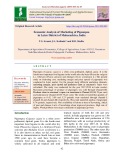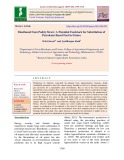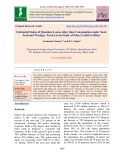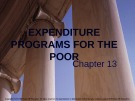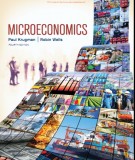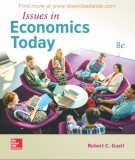
Producer surplus
-
Lecture Business mathematics - Chapter 3: Simultaneous equations. The main topics covered in this chapter include: solving simultaneous linear equations; equilibrium and break-even; consumer and producer surplus; the national income model and the IS-LM model; excel for simultaneous linear equations;... Please refer to this chapter for details!
 37p
37p  hanlamcoman
hanlamcoman
 26-11-2022
26-11-2022
 11
11
 2
2
 Download
Download
-
Lecture Chapter 7: Consumers, Producers, and the Efficiency of Markets, In this chapter you will: To measure of society’s well-being, we use total surplus, the sum of consumer and producer surplus. Efficiency means that total surplus is maximized, that the goods are produced by sellers with lowest cost, and that they are consumed by buyers who most value them. Under perfect competition, the market outcome is efficient. Altering it would reduce total surplus.
 48p
48p  123chichi
123chichi
 01-12-2021
01-12-2021
 27
27
 1
1
 Download
Download
-
Lecture Microeconomics - Chapter 5: Consumers, Producers and the Efficiency present the content consumer surplus, demand curve, producer surplus, supply curve, market efficiency, Welfare economics...
 24p
24p  xusong
xusong
 12-07-2021
12-07-2021
 9
9
 1
1
 Download
Download
-
In this chapter you will examine how taxes reduce consumer and producer surplus, learn the meaning and causes of the deadweight loss of a tax, consider why some taxes have larger deadweight losses than others, examine how tax revenue and deadweight loss vary with the size of a tax.
 17p
17p  larachdumlanat125
larachdumlanat125
 01-12-2020
01-12-2020
 21
21
 1
1
 Download
Download
-
Lecture Principles of Microeconomics: Chapter 6 - Wealth creation and destruction. After reading this chapter, you should be able to answer the following questions: What is wealth? What creates wealth? How is wealth destroyed? What is consumers’ surplus? What is producers’ surplus? When is total surplus to society maximized? What is deadweight loss? How do government set prices, taxes and subsidies create deadweight loss? How do innovations affect a market economy?
 28p
28p  koxih_kothogmih10
koxih_kothogmih10
 26-10-2020
26-10-2020
 16
16
 1
1
 Download
Download
-
Chapter 4 - Consumer surplus, producer surplus, and economic efficiency. After completing this unit, you should be able to: Describe consumer surplus, producer surplus, economic surplus, and deadweight loss; illustrate and compute consumer surplus, producer surplus, and deadweight loss; describe how economic surplus can represent social welfare and economic efficiency.
 17p
17p  koxih_kothogmih7
koxih_kothogmih7
 29-09-2020
29-09-2020
 13
13
 0
0
 Download
Download
-
Chapter 4 - Consumer surplus, producer surplus, and economic efficiency. After completing this unit, you should be able to: Describe consumer surplus, producer surplus, economic surplus, and deadweight loss; illustrate and compute consumer surplus, producer surplus, and deadweight loss; describe how economic surplus can represent social welfare and economic efficiency.
 17p
17p  koxih_kothogmih8
koxih_kothogmih8
 29-09-2020
29-09-2020
 15
15
 0
0
 Download
Download
-
Chapter 4 - Market failures: public goods and externalities. This chapter seeks to define a market failure and the consequences of a market failure. The chapter begins by looking at the demand side of market failures, the supply side of market failures, and the inefficiencies found. It goes on to describe and show consumer and producer surplus. It defines and describes private goods, public goods, the free-rider problem, and quasi-public goods.
 19p
19p  nanhankhuoctai10
nanhankhuoctai10
 23-07-2020
23-07-2020
 17
17
 1
1
 Download
Download
-
A buoyant investment in Indian agriculture sector is necessary to ensure food security, provide livelihood to a large proportion of the workforce, contribute to the growth of the economy by producing goods, raw materials for industry and goods for exports, generate surpluses and provide market for non-agricultural goods. Capital formation in agriculture is a crucial component of growth and development in agriculture. Hence, it is a priority issue and much debated one by researchers and policy makers.
 9p
9p  trinhthamhodang1213
trinhthamhodang1213
 29-05-2020
29-05-2020
 8
8
 1
1
 Download
Download
-
Pigeonpea (Cajanus cajan) is a often cross-pollinated, diploid, grain. It is the fourth most important food legume in the world after dry bean (Phaseolus vulgaris L.), field pea (Pisum sativum) and chickpea (Cicer arientinum L.) The present study on marketing cost, marketing margin and price spread of pigeonpea was conducted in Latur market. For the present study different marketing channels, marketing margins, price spread and producers share in consumer’s rupee were calculated. The study was conducted for the year 2017-2018 in Latur market.
 6p
6p  caygaocaolon3
caygaocaolon3
 27-02-2020
27-02-2020
 15
15
 0
0
 Download
Download
-
Production of biofuels, especially bio-ethanol from lignocellulosic biomass, holds remarkable potential to meet the current energy demand as well as to mitigate greenhouse gas emissions for a sustainable clean environment. Rice is one of the most important agricultural crops in India. Rice straw is an important residue which is generated in large amount in India. Every kilogram of grain harvesting is accompanied by the production of rice straw to a tune of 1.0–1.5 kg. Major proportion of the rice straw is burnt in the field itself.
 8p
8p  cothumenhmong3
cothumenhmong3
 22-02-2020
22-02-2020
 14
14
 0
0
 Download
Download
-
The present investigation was carried out to study the various marketing aspects of onion such as pattern of disposal, market practices and intermediaries involved in channels of marketing, and per unit cost of marketing for different size groups in Nashik district of Maharashtra. For the study of market, Lasalgaon APMC was selected. A sample of 131 farmers was interviewed of which 93 were small, 26 were medium and 12 were large. The marketed surplus was highest for large farmers (76.65 per cent) followed by medium size farms (74.68 per cent) and small size farm groups (67.39 per cent).
 10p
10p  kethamoi2
kethamoi2
 14-12-2019
14-12-2019
 12
12
 0
0
 Download
Download
-
The study conducted in the state of Bihar has examined, the quantity losses other than consumption for lentil crop amongst different farm size groups. It has found that at overall level 46.91 percent of the total lentil crop produced was available as marketable surplus. At the overall level study finds about 19.56 percent of the total lentil produce goes wastage as seed, feed, and wastage however only 80.44 percent available for consumption purpose.
 8p
8p  kequaidan2
kequaidan2
 13-12-2019
13-12-2019
 9
9
 0
0
 Download
Download
-
In this chapter, the following content will be discussed: istinguish between the private and public sector approaches to project evaluation; explain the net present value approach to project evaluation and compare it with the internal rate of return and the benefit-cost ratio; show why, under ideal conditions, public sector projects should strive to maximise consumer (and producer) surplus;...
 21p
21p  thiendiadaodien_8
thiendiadaodien_8
 24-02-2019
24-02-2019
 33
33
 4
4
 Download
Download
-
Learning objectives of this chapter include: Distinguish between the private and public sector approaches to project evaluation; explain the net present value approach to project evaluation and compare it with the internal rate of return and the benefit-cost ratio; show why, under ideal conditions, public sector projects should strive to maximise consumer (and producer) surplus;...
 23p
23p  thiendiadaodien_8
thiendiadaodien_8
 24-02-2019
24-02-2019
 36
36
 3
3
 Download
Download
-
In this chapter, the following content will be discussed: Distinguish between the private and public sector approaches to project evaluation; explain the net present value approach to project evaluation and compare it with the internal rate of return and the benefit-cost ratio; show why, under ideal conditions, public sector projects should strive to maximise consumer (and producer) surplus;...
 25p
25p  thiendiadaodien_8
thiendiadaodien_8
 24-02-2019
24-02-2019
 47
47
 4
4
 Download
Download
-
This paper deals with using stainless steel reducing slag (SSRS), a byproduct generated from stainless steel making process, as a cement substitute in production of soil-based controlled low-strength material (CLSM). In the CLSM mixture, surplus soil and river sand were blended well together with a sand-soil proportion of 6:4 by volume in order to produce fine aggregate. Totally, twelve mixtures were prepared for experiment when we changed in turn percentages of Portland cement replacement with SSRS of 0%, 10%, 20%, and 30% by weight and the water-to-binder ratio of 3.4, 3.6, and 3.8.
 5p
5p  cathydoll5
cathydoll5
 26-02-2019
26-02-2019
 19
19
 0
0
 Download
Download
-
(bq) part 1 book "microeconomics" has contents: first principles; supply and demand, consumer and producer surplus, price controls and quotas - meddling with markets, international trade, decision making by individuals and firms
 314p
314p  bautroibinhyen30
bautroibinhyen30
 15-06-2017
15-06-2017
 42
42
 4
4
 Download
Download
-
(bq) part 1 book "issues in economics today" has contents: supply and demand, the concept of elasticity and consumer and producer surplus; firm production, cost, and revenue; perfect competition, monopoly, and economic versus normal profit; interest rates and present value; monetary policy; fiscal policy; federal spending,...and other contents.
 270p
270p  bautroibinhyen27
bautroibinhyen27
 11-05-2017
11-05-2017
 53
53
 7
7
 Download
Download
-
(bq) part 1 book "microecomomics" has contents: first principles, economic models - trade offs and trade, supply and demand, consumer and producer surplus, international trade, decision making by individuals and firms, the rational consumer,...and other contents.
 301p
301p  bautroibinhyen27
bautroibinhyen27
 11-05-2017
11-05-2017
 42
42
 3
3
 Download
Download
CHỦ ĐỀ BẠN MUỐN TÌM














